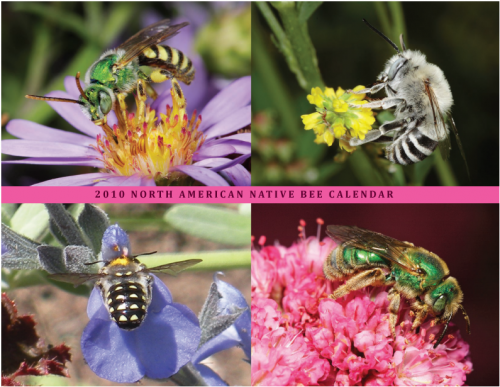Humans aren't the only calendar pin-up models.
Think native bees.
Think the 2010 Native Bees Calendar.
The Xerces Society and the Great Sunflower Project have joined forces to produce a calendar showcasing 12 commonly found native bees. You'll be able not only to to identity them, but to learn more about them, such as the plants they prefer and their nesting needs.
What are these two organizations?
The Great Sunflower Project, led by San Francisco State University associate professor Gretchen LeBuhn, "empowers people from pre-schoolers to scientists to make the world a better place for bees. The idea is simple; gardeners plant a sunflower and time how long it takes for five bees to visit. Gardens that quickly see bees are healthy. Gardens that don’t see bees aren’t. The sunflowers are both a thermometer measuring the health of the bee community across the continent and a wonderful resource making each garden where they are planted a better place for bees."
The Xerces Society for Invertebrate Conservation, headquartered in Portland, Ore., is "an international nonprofit organization dedicated to preserving the diversity of life through the protection of invertebrates and their habitats," says Xerces Society senior conservation associate Matthew Shepherd. The group "works at the forefront of invertebrate protection, harnessing the knowledge of scientists and the enthusiasm of local citizens to implement conservation and education programs with a focus on endangered species, aquatic invertebrates, and pollinators."
One of the nation’s leading native bee conservation organizations, the Xerces Society provides advice and information to gardeners, land owners, farmers, agency staff and other interested persons.
The native bee photos are by noted insect photographer Rollin Coville, who received his doctorate in entomology from UC Berkeley in 1978. His close-ups are truly magnificent. (You can also see more of his work on his Web site.) Coville collaborates with scientists Gordon Frankie of UC Berkeley and Robbin Thorp of UC Davis on a number of projects involving the study of urban bees. Their work recently appeared in the California Agriculture journal.Shepherd tells us the story behind the story. "Celeste Ets-Hokin, a bee enthusiast in the San Francisco Bay area, came up with the idea and pursued it. At Xerces, we've considered doing a calendar but had always shied away from it because of the time involved. Celeste took the idea to Gretchen LeBuhn, who was looking for fundraising ideas for the Great Sunflower Project. The calendar is really their project and they should get credit for it."
Shepherd modestly says his contribution "has been to answer Celeste's steady stream of questions."
At this link, you can see a sample page from the calendar. The calendar is available for purchase for $14 (order by Nov. 30) from the Xerces Society and Great Sunflower Project Web sites.
Well done, and for two good causes.
And who says bees can't be pin-up models?
Attached Images:

Spectacular Photography